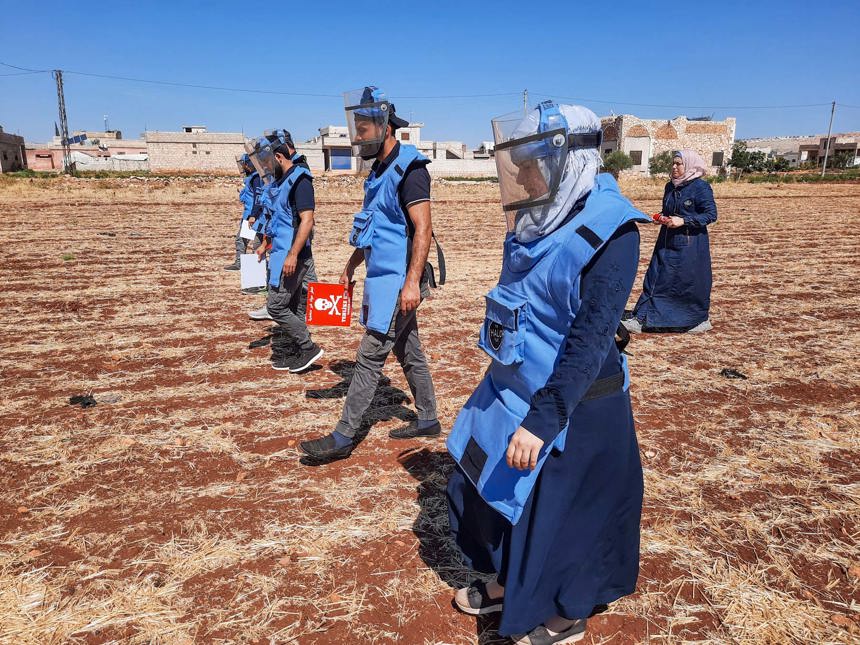The silent slaughter of civilians - including children - killed by landmines
According to Halo Trust since early December, coinciding with the fall of Assad, at least 144 people have been killed, including 27 children. Last year, at least 212 civilians lost their lives to explosive remnants of war, including 28 women and 63 children. Land clearance work critical to a true rebirth of the country.
Damascus (AsiaNews) - At least 144 people killed since early December, including at least 27 children, struck dead by landmines scattered around the grounds and inside homes or struck by unexploded ordnance, a legacy of the conflict still ongoing in some areas.
Since the fall of the regime in Damascus, with President Bashar al-Assad's hasty flight to Russia following the advance of Hay'at Tahrir al-Sham (Hts) militiamen, a new front of emergency has opened up for a civilian population: buried ordnance in the ground, joining the effects of the ongoing war, sanctions and the “poverty bomb.” Raising the alarm is the international NGO Halo Trust, which specializes in de-mining and defusing ordnance, which is calling for stepped-up clearance operations to avert further casualties.
An emergency also confirmed by activists from the Syrian Observatory for Human Rights (Sohr), according to which eight civilians have been killed and at least 13 wounded, including 10 children, since the beginning of the year due to mine-anti-personnel device triggers.
The latest incident occurred in the village of Dughanka and coincides with the gradual return of displaced Kurdish families to Afrin in northwest Syria. Also according to the UK-based activist movement with a dense network of informants on the ground, at least 212 civilians lost their lives to explosive remnants of war last year, including 28 women and 63 children. The remnants of the Syrian conflict, Sohr explained, “have turned many parts of the country into dangerous areas, preventing displaced families from safely returning to their homes.”
Halo Trust experts released a report in early January showing an “unprecedented threat” to civilians from “millions of mines, weapons and ammunition” in towns and villages that are being repopulated after being abandoned for the civil war.
Exacerbating the danger is the fact that there is still no comprehensive mapping and detailed information on the areas where the presence of mines abandoned by the various warring factions, from rebels to jihadist groups to Assad's former loyalist army, is most concentrated. And particularly at risk are children, who play in areas where no mines or other explosives have been identified.
Among the latest testimonies collected by the U.K.-based NGO is the tragedy of two children shot dead by mines while picking olives in fields in the northwestern province of Idlib. And again, a family of three returning to check on the condition of their house abandoned to flee crossfire killed when a device planted inside the building exploded.
Mouiad Alnofaly, Halo Trust manager in Syria, explains to The National that despite the end of the civil war, there is still the danger of “millions of unexploded mines and munitions,” which leave “a deadly legacy that will kill and maim generations to come.”
There are two elements of particular concern: on the one hand, “millions of people who are returning or planning to return,” and on the other hand, the lack of certain information “about dangerous areas.” Alnofaly said he “cannot describe the terrible feeling” he feels at seeing his compatriots killed at a time of relative hope for the country.
Already a hundred minefields have been found on the front line of previous fighting in the last period, and “there have been terrible incidents on a daily basis” caused by unexploded ordnance.
“Entire families,” the activist points out, ”have been killed because their child mistook a grenade for precious scrap metal. Especially young children “are not aware of the dangers and contaminated areas, they go out to play in their gardens but most of the mined areas are not known.” “That is why,” he explains, ”we have started risk education with schools, but we do not have the capacity to cover the whole country.
Another cause of death is related to unexploded ammunition, which people-particularly the poorest and with no other resources to survive-try to sell thinking it is scrap metal from which to make small amounts of money.
The United Nations says that about one-third of the Syrian population is affected by some form of explosives contamination, with the highest rates in the governorates of Quneitra, Suweida, rural Damascus, Aleppo, Idlib, Raqqa, Deir Ezzor, and Deraa.
Numbers released by activist movements frame the tragedy: 3,353 civilians, including 889 children, have been killed by landmines in Syria since 2011.
Halo Trust was founded in 1988 and employs 13,000 deminers in more than 30 countries including Ukraine, Afghanistan, Angola and Yemen. With experience gained in theaters of war, the NGO calls for investment in security, a prerequisite for true reconstruction of the country devastated by nearly 15 years of conflict.
Alnofaly said Halo estimates that a million a year explosive ordnance clearance and disposal operation would save thousands of lives and help restore Syria's shattered economy. “Safe demining costs money,” he concludes, ‘but it is not a huge price to pay’ in a real prospect of recovery.
03/11/2016 15:57
10/06/2015







.png)










